Warsaw Uprising
From Wikipedia, the free encyclopedia
For other uses, see Warsaw Uprising (disambiguation).
|
||||||||||||||||||||||||||||||
|
||||||||||||||||||||||||||||||
The Uprising began on 1 August 1944, as part of a nationwide plan, Operation Tempest, when the Soviet Army approached Warsaw. The main Polish objectives were to drive the German occupiers from the city and help with the larger fight against Germany and the Axis powers. Secondary political objectives were to liberate Warsaw before the Soviets, to underscore Polish sovereignty by empowering the Polish Underground State before the Soviet-backed Polish Committee of National Liberation could assume control. Also, short-term causes included the threat of a German round-up of able-bodied Poles, and Moscow radio calling for the Uprising to begin.
Initially, the Poles established control over most of central Warsaw, but the Soviets ignored Polish attempts to establish radio contact and did not advance beyond the city limits. Intense street fighting between the Germans and Poles continued. By 14 September, Polish forces under Soviet high command occupied the east bank of the Vistula river opposite the resistance positions; but only 1,200 men made it across to the west bank, and they were not reinforced by the bulk of the Red Army. This, and the lack of Soviet air support from a base 5 minutes flying time away, led to allegations that Joseph Stalin tactically halted his forces to let the operation fail and allow the Polish resistance to be crushed. Arthur Koestler called the Soviet attitude "one of the major infamies of this war which will rank for the future historian on the same ethical level with Lidice."[11]
Winston Churchill pleaded with Stalin and Franklin D. Roosevelt to help Britain's Polish allies, to no avail. Then, without Soviet air clearance, Churchill sent over 200 low-level supply drops by the Royal Air Force, the South African Air Force and the Polish Air Force under British High Command. Later, after gaining Soviet air clearance, the US Army Air Force sent one high-level mass airdrop as part of Operation Frantic. The Soviet Union refused to allow American bombers from Western Europe to land on Soviet airfields after dropping supplies to the Poles.[12]
Although the exact number of casualties remains unknown, it is estimated that about 16,000 members of the Polish resistance were killed and about 6,000 badly wounded. In addition, between 150,000 and 200,000 Polish civilians died, mostly from mass executions. Jews being harboured by Poles were exposed by German house-to-house clearances and mass evictions of entire neighbourhoods. German casualties totalled over 8,000 soldiers killed and missing, and 9,000 wounded. During the urban combat approximately 25% of Warsaw's buildings were destroyed. Following the surrender of Polish forces, German troops systematically leveled another 35% of the city block by block. Together with earlier damage suffered in the 1939 invasion of Poland and the Warsaw Ghetto Uprising in 1943, over 85% of the city was destroyed by January 1945, when the course of the events in the Eastern Front forced the Germans to abandon the city.
Background
See also: Prelude to the Warsaw Uprising
We have one point from which every evil emanates. That point is Warsaw. If we didn't have Warsaw in the General Government, we wouldn't have four-fifths of the difficulties with which we must contend.By July 1944, Poland had been occupied by the forces of Nazi Germany for almost five years. The Polish Home Army, which was loyal to the Polish government-in-exile, had long planned some form of insurrection against the occupiers. Germany was fighting a coalition of Allied powers, led by the Soviet Union, the United Kingdom and the United States. The initial plan of the Home Army was to link up with the invading forces of the Western Allies as they liberated Europe from the Nazis. However, in 1943 it became apparent that the Soviets, rather than the Western Allies, would reach the pre-war borders of Poland before the Allied invasion of Europe made notable headway.[14]
The Soviets and the Poles had a common enemy—Nazi Germany—but other than that, they were working towards different post-war goals; the Home Army desired a pro-Western, democratic-capitalist Poland, but the Soviet leader Stalin intended to establish a communist, pro-Soviet regime. It became obvious that the advancing Soviet Red Army might not come to Poland as an ally but rather only as "the ally of an ally".[15]

Polish flag with an "anchor" device was used as an emblem by the Polish resistance.
However, the Home Army commander, Tadeusz Bór-Komorowski, took a different approach, and on 20 November, he outlined his own plan, which became known as Operation Tempest. On the approach of the Eastern Front, local units of the Home Army were to harass the German Wehrmacht in the rear and co-operate with incoming Soviet units as much as possible. Although doubts existed about the military necessity of a major uprising, planning continued.[18] General Bór-Komorowski and his civilian advisor, were authorised by the government in exile to proclaim a general uprising whenever they saw fit.[19]
Eve of the battle
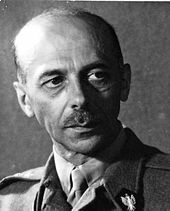
Commander Tadeusz Bór-Komorowski of the Polish Home Army.
In the early summer of 1944, German plans required Warsaw to serve as the defensive centre of the area and to be held at all costs. The Germans had fortifications constructed and built up their forces in the area. This process slowed after the failed 20 July plot to assassinate the Nazi leader Adolf Hitler, and around that time, the Germans in Warsaw were weak and visibly demoralized.[24][25] However, by the end of July, German forces in the area were reinforced.[24] On 27 July, the Governor of the Warsaw District, Ludwig Fischer, called for 100,000 Polish men and women to report for work as part of a plan which envisaged the Poles constructing fortifications around the city.[26] The inhabitants of Warsaw ignored his demand, and the Home Army command became worried about possible reprisals or mass round-ups, which would disable their ability to mobilize.[27] The Soviet forces were approaching Warsaw, and Soviet-controlled radio stations called for the Polish people to rise in arms.[24][28]
On 25 July, the Union of Polish Patriots, in a broadcast from Moscow, stated: "The Polish Army of Polish Patriots ... calls on the thousands of brothers thirsting to fight, to smash the foe before he can recover from his defeat ... Every Polish homestead must become a stronghold in the struggle against the invaders ... Not a moment is to be lost."[29] On 29 July, the first Soviet armoured units reached the outskirts of Warsaw, where they were counter-attacked by two German Panzer Corps: the 39th and 4th SS.[30] On 29 July 1944 Radio Station Kosciuszko located in Moscow emitted a few times its "Appeal to Warsaw" and called to "Fight The Germans!": "No doubt Warsaw already hears the guns of the battle which is soon to bring her liberation. ... The Polish Army now entering Polish territory, trained in the Soviet Union, is now joined to the People's Army to form the Corps of the Polish Armed Forces, the armed arm of our nation in its struggle for independence. Its ranks will be joined tomorrow by the sons of Warsaw. They will all together, with the Allied Army pursue the enemy westwards, wipe out the Hitlerite vermin from Polish land and strike a mortal blow at the beast of Prussian Imperialism."[31][32] Bór-Komorowski and several high-ranking officers held a meeting on that day. Jan Nowak-Jeziorański, who had recently arrived from London, expressed the view that support from the Allies would be weak, but his points received little attention.[33] Believing that the time for action had arrived, on 31 July, the Polish commanders General Tadeusz Bór-Komorowski and Colonel Antoni Chruściel ordered full mobilization of Home Army forces for 17:00 the following day.[34]
Opposing forces
Main article: List of military units in the Warsaw Uprising
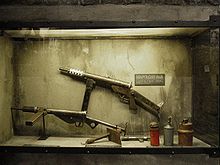
Weapons used by the resistance, including the Błyskawica submachine gun—one of very few weapons designed and mass-produced covertly in occupied Europe.
"Within the framework of the entire enemy intelligence operations directed against Germany, the intelligence service of the Polish resistance movement assumed major significance. The scope and importance of the operations of the Polish resistance movement, which was ramified down to the smallest splinter group and brilliantly organized, have been in (various sources) disclosed in connection with carrying out of major police security operations." – Heinrich Himmler, 31 December 1942[35]
Poles
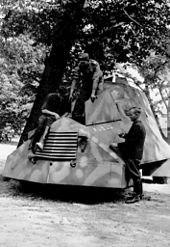
Kubuś
an armoured car made by the Home Army during the Uprising. A single
unit was build by the "Krybar" Regiment on the chassis of a Chevrolet
157 van.
Germans
In late July 1944 the German units stationed in and around Warsaw were divided into three categories. The first and the most numerous was the garrison of Warsaw. As of 31 July, it numbered some 11,000 troops under General Rainer Stahel.[48]During the uprising the German side received reinforcements on a daily basis, and Stahel was replaced as overall commander by SS-General Erich von dem Bach in early August. As of 20 August 1944, the German units directly involved with fighting in Warsaw comprised 17,000 men arranged in two battle groups:[52] Battle Group Rohr (commanded by Major General Rohr), which included Bronislav Kaminski's brigade and Battle Group Reinefarth (commanded by SS-Gruppenführer Heinz Reinefarth) consisted of Attack Group Dirlewanger (commanded by Oskar Dirlewanger), Attack Group Reck (commanded by Major Reck), Attack Group Schmidt (commanded by Colonel Schmidt) and various support and backup units.[citation needed]
Uprising
Main article: Military history of the Warsaw Uprising
W-hour
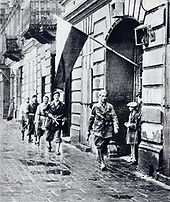
Lieutenant Stanisław Jankowski "Agaton" from "Pięść" Battalion on patrol during "W-hour" (17:00) at the start of the Uprising, 1 August 1944
That evening the resistance captured a major German arsenal, the main post office and power station and the tallest building in Warsaw, the Prudential building. However, Castle Square, the police district, and the airport remained in German hands.[58] The first two days were crucial in establishing the battlefield for the rest of the fight. The resistance fighters were most successful in the City Centre, Old Town, and Wola districts. However, several major German strongholds remained, and in some areas of Wola the Poles sustained heavy losses that forced an early retreat. In other areas such as Mokotów, the attackers almost completely failed to secure any objectives and controlled only the residential areas. In Praga, on the east bank of the Vistula, the Poles were sent back into hiding by a high concentration of German forces.[59] Most crucially, the fighters in different areas failed to link up, either with each other or with areas outside Warsaw, leaving each sector isolated from the others. After the first hours of fighting, many units adopted a more defensive strategy, while civilians began erecting barricades. Despite all the problems, by 4 August the majority of the city was in Polish hands, although some key strategic points remained untaken.[60]
First four days

The city's sewer system was used to move resistance fighters between the Old Town, Śródmieście and Żoliborz districts.

Captured German Sd.Kfz. 251 from the 5th SS Panzer Division Wiking, and pressed into service with the 8-th "Krybar" Regiment. The soldier holding a MP 40 submachine gun is commander Adam Dewicz "Gray Wolf", 14 August 1944
- Area I (city centre and the Old Town): Units captured most of their assigned territory, but failed to capture areas with strong pockets of resistance from the Germans (the Warsaw University buildings, PAST skyscraper, the headquarters of the German garrison in the Saxon Palace, the German-only area near Szucha Avenue, and the bridges over the Vistula). They thus failed to create a central stronghold, secure communication links to other areas, or a secure land connection with the northern area of Żoliborz through the northern railway line and the Citadel.[citation needed]
- Area II (Żoliborz, Marymont, Bielany): Units failed to secure the most important military targets near Żoliborz. Many units retreated outside of the city, into the forests. Although they captured most of the area around Żoliborz, the soldiers of Colonel Mieczysław Niedzielski ("Żywiciel") failed to secure the Citadel area and break through German defences at Warsaw Gdańsk railway station.[62]
- Area III (Wola): Units initially secured most of the territory, but sustained heavy losses (up to 30%). Some units retreated into the forests, while others retreated to the eastern part of the area. In the northern part of Wola the soldiers of Colonel Jan Mazurkiewicz ("Radosław") managed to capture the German barracks, the German supply depot at Stawki Street, and the flanking position at the Okopowa Street Jewish Cemetery.[citation needed]
- Area IV (Ochota): The units mobilized in this area did not capture either the territory or the military targets (the Gęsiówka concentration camp, and the SS and Sipo barracks on Narutowicz Square). After suffering heavy casualties most of the Home Army forces retreated to the forests west of Warsaw. Only two small units of approximately 200 to 300 men under Lieut. Andrzej Chyczewski ("Gustaw") remained in the area and managed to create strong pockets of resistance. They were later reinforced by units from the city centre. Elite units of the Kedyw managed to secure most of the northern part of the area and captured all of the military targets there. However, they were soon tied down by German tactical counter-attacks from the south and west.[citation needed]
- Area V (Mokotów): The situation in this area was very serious from the start of hostilities. The partisans aimed to capture the heavily defended Police Area (Dzielnica policyjna) on Rakowiecka Street, and establish a connection with the city centre through open terrain at the former airfield of Mokotów Field. As both of the areas were heavily fortified and could be approached only through open terrain, the assaults failed. Some units retreated into the forests, while others managed to capture parts of Dolny Mokotów, which was, however, severed from most communication routes to other areas.[63]
- Area VI (Praga): The Uprising was also started on the right bank of the Vistula, where the main task was to seize the bridges on the river and secure the bridgeheads until the arrival of the Red Army. It was clear that, since the location was far worse than that of the other areas, there was no chance of any help from outside. After some minor initial successes, the forces of Lt.Col. Antoni Żurowski ("Andrzej") were badly outnumbered by the Germans. The fights were halted, and the Home Army forces were forced back underground.[53]
- Area VII (Powiat warszawski): this area consisted of territories outside Warsaw city limits. Actions here mostly failed to capture their targets.[citation needed]
Among the most notable primary targets that were not taken during the opening stages of the uprising were the airfields of Okęcie and Mokotów Field, as well as the PAST skyscraper overlooking the city centre and the Gdańsk railway station guarding the passage between the centre and the northern borough of Żoliborz.[citation needed]
Wola massacre
Main article: Wola massacre
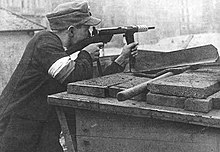
Home Army soldier armed with Błyskawica submachine gun defending a barricade in Powiśle District of Warsaw during the Uprising, August 1944
On 5 August Reinefarth's three attack groups started their advance westward along Wolska and Górczewska streets toward the main East-West communication line of Jerusalem Avenue. Their advance was halted, but the regiments began carrying out Heinrich Himmler's orders: behind the lines, special SS, police and Wehrmacht groups went from house to house, shooting the inhabitants regardless of age or gender and burning their bodies.[53] Estimates of civilians killed in Wola and Ochota range from 20,000 to 50,000,[64] 40,000 by 8 August in Wola alone,[65] or as high as 100,000.[66] The main perpetrators were Oskar Dirlewanger and Bronislav Kaminski, whose forces committed the cruelest atrocities.[67][68][69]
The policy was designed to crush the Poles' will to fight and put the uprising to an end without having to commit to heavy city fighting.[70] With time, the Germans realized that atrocities only stiffened resistance and that some political solution should be found, as the thousands of men at the disposal of the German commander were unable to effectively counter the resistance in an urban guerrilla setting.[71] They aimed to gain a significant victory to show the Home Army the futility of further fighting and induce them to surrender. This did not succeed. Until mid-September, the Germans shot all captured resistance fighters on the spot, but from the end of September, some of the captured Polish soldiers were treated as POWs.[72]
Stalemate
"This is the fiercest of our battles since the start of the war. It compares to the street battles of Stalingrad." – SS chief Heinrich Himmler to German generals on 21 September 1944.[73]

Jewish prisoners of Gęsiówka concentration camp liberated by Polish Home Army soldiers from "Zośka" Battalion, 5 August 1944

German Stuka Ju-87 bombing Warsaw's Old Town, August 1944
Between 9 and 18 August pitched battles raged around the Old Town and nearby Bankowy Square, with successful attacks by the Germans and counter-attacks from the Poles. German tactics hinged on bombardment through the use of heavy artillery[74] and tactical bombers, against which the Poles were unable to effectively defend, as they lacked anti-aircraft artillery weapons. Even clearly marked hospitals were dive-bombed by Stukas.[75]
Although the Battle of Stalingrad had already shown the danger a city can pose to armies which fight within it and the importance of local support, the Warsaw Uprising was probably the first demonstration that in an urban terrain, a vastly under-equipped force supported by the civilian population can hold its own against better-equipped professional soldiers—though at the cost of considerable sacrifice on the part of the city's residents.[citation needed]
The Poles held the Old Town until a decision to withdraw was made at the end of August. On successive nights until 2 September, the defenders of the Old Town withdrew through the sewers, which were a major means of communication between different parts of the Uprising.[76] Thousands of people were evacuated in this way. Those that remained were either shot or transported to concentration camps like Mauthausen and Sachsenhausen once the Germans regained control.[77]
Berling's landings
Soviet attacks on the 4th SS Panzer Corps east of Warsaw were renewed on 26 August, and the Germans were forced to retreat into Praga. The Soviet army under the command of Konstantin Rokossovsky captured Praga and arrived on the east bank of the Vistula in mid-September. By 13 September, the Germans had destroyed the remaining bridges over the Vistula, signalling that they were abandoning all their positions east of the river.[78] In the Praga area, Polish units under the command of General Zygmunt Berling (thus sometimes known as berlingowcy – "the Berling men") fought on the Soviet side. Three patrols of his First Polish Army (1 Armia Wojska Polskiego) landed in the Czerniaków and Powiśle areas and made contact with Home Army forces on the night of 14/15 September. The artillery cover and air support provided by the Soviets was unable to effectively counter enemy machine-gun fire as the Poles crossed the river, and the landing troops sustained heavy losses.[79] Only small elements of the main units made it ashore (I and III battalions of 9th infantry regiment, 3rd Infantry Division).[80]
Monument to General Berling in Warsaw, in the background is the Łazienkowski Bridge.
The Germans intensified their attacks on the Home Army positions near the river to prevent any further landings, but were not able to make any significant advances for several days while Polish forces held those vital positions in preparation for a new expected wave of Soviet landings. Polish units from the eastern shore attempted several more landings, and from 15 to 23 September sustained heavy losses (including the destruction of all their landing boats and most of their other river crossing equipment).[80] Red Army support was inadequate.[80] After the failure of repeated attempts by the 1st Polish Army to link up with the insurgents, the Soviets limited their assistance to sporadic artillery and air support. Conditions that prevented the Germans from dislodging the resistance also acted to prevent the Poles from dislodging the Germans. Plans for a river crossing were suspended "for at least 4 months", since operations against the 9th Army's five panzer divisions were problematic at that point, and the commander of the 1st Polish Army, General Berling was relieved of his duties by his Soviet superiors.[16][81]
On the night of 19 September, after no further attempts from the other side of the river were made and the promised evacuation of wounded did not take place, Home Army soldiers and landed elements of the 1st Polish Army were forced to begin a retreat from their positions on the bank of the river.[80] Out of approximately 900 men who made it ashore only a handful made it back to the eastern shore of the Vistula.[82] Berling's Polish Army losses in the attempt to aid the Uprising were 5,660 killed, missing or wounded.[7] From this point on, the Warsaw Uprising can be seen as a one-sided war of attrition or, alternatively, as a fight for acceptable terms of surrender. The Poles were besieged in three areas of the city: Śródmieście, Żoliborz and Mokotów.[citation needed]
Life behind the lines
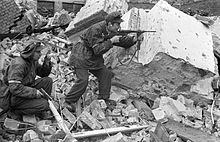
Home Army soldiers Henryk Ożarek "Henio" (left) holding a Vis pistol and Tadeusz Przybyszewski "Roma" (right) firing a Błyskawica submachine gun, from "Anna" Company of the "Gustaw" Battalion fighting on Kredytowa-Królewska Street, 3 October 1944
Food shortages
Another serious problem for civilians and soldiers alike was a shortage of water.[53] By mid-August most of the water conduits were either out of order or filled with corpses. In addition, the main water pumping station remained in German hands.[53] To prevent the spread of epidemics and provide the people with water, the authorities ordered all janitors to supervise the construction of water wells in the backyards of every house. On 21 September the Germans blew up the remaining pumping stations at Koszykowa Street and after that the public wells were the only source of potable water in the besieged city.[85] By the end of September, the city centre had more than 90 functioning wells.[53]
Polish media
 |
|
| Problems playing this file? See media help. | |
The Błyskawica long-range radio transmitter, assembled on 7 August in the city centre, was run by the military, but was also used by the recreated Polish Radio from 9 August.[53] It was on the air three or four times a day, broadcasting news programmes and appeals for help in Polish, English, German and French, as well as reports from the government, patriotic poems and music.[88] It was the only such radio station in German-held Europe.[89] Among the speakers appearing on the insurgent radio were Jan Nowak-Jeziorański,[90] Zbigniew Świętochowski, Stefan Sojecki, Jeremi Przybora,[91] and John Ward, a war correspondent for The Times of London.[92]
Limited outside support

Captured German Panther tank by resistance fighters from "Zośka" Battalion under the command of Wacław Micuta, 2 August 1944
Main article: Lack of outside support in the Warsaw Uprising
According to many historians, a major cause of the eventual failure
of the uprising was the almost complete lack of outside support and the
late arrival of that which did arrive.[7][30]
The Polish government-in-exile carried out frantic diplomatic efforts
to gain support from the Western Allies prior to the start of battle but
the allies would not act without Soviet approval. The Polish government
in London asked the British several times to send an allied mission to
Poland.[16] However, the British mission did not arrive until December 1944.[93] Shortly after their arrival, they met up with Soviet authorities, who arrested and imprisoned them.[94] In the words of the mission's deputy commander, it was "a complete failure".[95] Nevertheless, from August 1943 to July 1944, over 200 British Royal Air Force
(RAF) flights dropped an estimated 146 Polish personnel trained in
Great Britain, over 4000 containers of supplies, and $16 million in
banknotes and gold to the Home Army.[96]The only support operation which ran continuously for the duration of the Uprising were night supply drops by long-range planes of the RAF, other British Commonwealth air forces, and units of the Polish Air Force, which had to use distant airfields in Italy, reducing the amount of supplies they could carry. The RAF made 223 sorties and lost 34 aircraft. The effect of these airdrops was mostly psychological—they delivered too few supplies for the needs of the resistance, and many airdrops landed outside Polish-controlled territory.[citation needed]
Airdrops
Main article: Warsaw airlift
"There was no difficulty in finding Warsaw. It was visible from 100 kilometers away. The city was in flames but with so many huge fires burning, it was almost impossible to pick up the target marker flares." – William Fairly, a South African pilot, from an interview in 1982[97]

Home Army soldiers from "Zośka" Battalion liberating Gęsiówka concentration camp. Only Juliusz Deczkowski
(centre) survived. Tadeusz Milewski "Ćwik" (right) was killed later in
the day and Wojciech Omyła "Wojtek" (left) was killed several days
later, 5 August 1944
The Soviet Union did not allow the Western Allies to use its airports for the airdrops,[7] so the planes had to use bases in the United Kingdom and Italy which reduced their carrying weight and number of sorties. The Allies' specific request for the use of landing strips made on 20 August was denied by Stalin on 22 August.[97] Stalin referred to the Polish resistance as "a handful of criminals"[101] and stated that the Uprising was inspired by "enemies of the Soviet Union".[102] Thus, by denying landing rights to Allied aircraft on Soviet-controlled territory the Soviets vastly limited effectiveness of Allied assistance to the Uprising, and even fired at Allied airplanes which carried supplies from Italy and strayed into Soviet-controlled airspace.[97]
American support was also limited. After Stalin's objections to supporting the uprising, British Prime Minister Winston Churchill telegraphed U.S. President Franklin D. Roosevelt on 25 August and proposed sending planes in defiance of Stalin, to "see what happens". Unwilling to upset Stalin before the Yalta Conference, Roosevelt replied on 26 August: "I do not consider it advantageous to the long-range general war prospect for me to join you".[97][103]

Soldier from the "Kiliński" Battalion pictured aiming his rifle at the German-occupied PAST building, 20 August 1944
Between 13 and 30 September Soviet aircraft commenced their own re-supply missions, dropping arms, medicines and food supplies. Initially these supplies were dropped in canisters without parachutes[110] which led to damage and loss of the contents.[111] Also, a large number of canisters fell into German hands. The Soviet Air Forces flew 2535 re-supply sorties with small bi-plane Polikarpov Po-2's, delivering a total of 156 50-mm mortars, 505 anti-tank rifles, 1478 sub-machine guns, 520 rifles, 669 carbines, 41 780 hand grenades, 37 216 mortar shells, over 3 mln. cartridges, 131.2 tons of food and 515 kg of medicine.[112]
Although German air defence over the Warsaw area itself was almost non-existent, about 12% of the 296 planes taking part in the operations were lost because they had to fly 1,600 km out and the same distance back over heavily defended enemy territory (112 out of 637 Polish and 133 out of 735 British and South African airmen were shot down).[102] Most of the drops were made during night, at no more than 30–90 m (100–300 ft) altitude, and poor accuracy left many parachuted packages stranded behind German-controlled territory (only about 50 tons of supplies, less than 50% delivered, was recovered by the insurgents).[98]
Soviet stance
"Fight The Germans! No doubt Warsaw already hears the guns of the battle which is soon to bring her liberation ... The Polish Army now entering Polish territory, trained in the Soviet Union, is now joined to the People's Army to form the Corps of the Polish Armed Forces, the armed arm of our nation in its struggle for independence. Its ranks will be joined tomorrow by the sons of Warsaw. They will all together, with the Allied Army pursue the enemy westwards, wipe out the Hitlerite vermin from Polish land and strike a mortal blow at the beast of Prussian Imperialism." – Moscow Radio Station Kosciuszko, 29 July 1944 broadcast[31]The role of the Red Army during the Warsaw Uprising remains controversial and is still disputed by historians.[30] The Uprising started when the Red Army appeared on the city's doorstep, and the Poles in Warsaw were counting on Soviet front capturing or forwarding beyond the city in a matter of days. This basic scenario of an uprising against the Germans, launched a few days before the arrival of Allied forces, played out successfully in a number of European capitals, such as Paris[113] and Prague. However, despite easy capture of area south-east of Warsaw barely 10 km from the city centre and holding these positions for about 40 days, the Soviets did not extend any effective aid to the insurgents within Warsaw. At that time city outskirts were defended by the under-manned and under-equipped German 73rd Infantry Division which was destroyed many times on the Eastern Front and was yet-again being reconstituted.[114] The weak German defence forces did not experience any significant Soviet pressure during that period, which effectively allowed them to strengthen German forces fighting against uprising in the city itself.
The Red Army was fighting intense battles further to the south of Warsaw, to seize and maintain bridgeheads over the Vistula river, and to the north of the city, to gain bridgeheads over the river Narew. The best German armoured divisions were fighting on those sectors. Despite the fact, both of these objectives had been mostly secured by September. Yet the Soviet 47th Army did not move into Praga (Warsaw's suburbs) on the right bank of the Vistula, until 11 September (when the Uprising was basically over). In three days the Soviets quickly gained control of the suburb, a few hundred meters from the main battle on the other side of the river, as the resistance by the German 73rd Division collapsed quickly. Had the Soviets done this in early August, the crossing of the river would have been easier, as the Poles then held considerable stretches of the riverfront. However, by mid-September a series of German attacks had reduced the Poles to holding one narrow stretch of the riverbank, in the district of Czerniaków. The Poles were counting on the Soviet forces to cross to the left bank where the main battle of the uprising was occurring. Though Berling's communist 1st Polish Army did cross the river, their support from the Soviets was inadequate and the main Soviet force did not follow them.[115]
One of the reasons given for the collapse of the Uprising was the reluctance of the Soviet Red Army to help the Polish resistance. On August 1, the day of Uprising, the Soviet advance was halted by a direct order from the Kremlin.[116] Soon afterwards the Soviet tank units stopped receiving any oil from their depots.[116] Soviets knew of the planned outbreak from their agents in Warsaw and, more importantly, directly from the Polish Prime Minister Stanisław Mikołajczyk, who informed them of the Polish Home Army uprising plans:[116][117] The Red Army's halt and lack of support for the Polish resistance is seen as a calculated decision by Stalin to achieve certain post-war political objectives.[16] In other words: had the Polish Home Army triumphed, the Polish government-in-exile would have had legitimacy to continue the pre-war government in Poland, rendering the post-war Polish-communists regime invalid and likely rejected in all of the pre-war Polish areas thus far liberated by the Red Army (the news of planned Warsaw Uprising is likely one of the reason of speeding up the installation of communist regime on July 22, 1944 in Lublin). Also the destruction of the main Polish resistance forces by the Germans was of direct benefit to Soviet Union, since it significantly weakened any potential Polish opposition to planned (and already started) Soviet occupation. Halting the advance and taking Warsaw in January 1945 enabled the Soviets to say they "liberated" Warsaw.[16]
One way or the other, the presence of Soviet tanks in nearby Wołomin 15 kilometers to the east of Warsaw had sealed the decision of the Home Army leaders to launch the Uprising. However, as a result of the initial battle of Radzymin in the final days of July, these advance units of the Soviet 2nd Tank Army were pushed out of Wołomin and back about 10 km.[118][119][120] On 9 August, Stalin informed Premier Mikołajczyk that the Soviets had originally planned to be in Warsaw by 6 August, but a counter-attack by four Panzer divisions had thwarted their attempts to reach the city.[121] By 10 August, the Germans had enveloped and inflicted heavy casualties on the Soviet 2nd Tank Army at Wołomin.[30]
When Stalin and Churchill met face-to-face in October 1944, Stalin told Churchill that the lack of Soviet support was a direct result of a major reverse in the Vistula sector in August, which had to be kept secret for strategic reasons.[122] All contemporary German sources assumed that the Soviets were trying to link up with the resistance, and they believed it was their defence that prevented the Soviet advance rather than a reluctance to advance on the part of the Soviets.[123] Nevertheless, as part of their strategy the Germans published propaganda accusing both the British and Soviets of abandoning the Poles.[124]

Picture of the Uprising taken from the opposite side of the Vistula river. Kierbedź Bridge viewed from Praga District towards Royal Castle and the Old Town, 1944
Other explanations for Soviet conduct are possible. The Red Army geared for a major thrust into the Balkans through Romania in mid-August and a large proportion of Soviet resources was sent in that direction, while the offensive in Poland was put on hold.[126] Stalin had made a strategic decision to concentrate on occupying Eastern Europe, rather than on making a thrust toward Germany.[127] The capture of Warsaw was not essential for the Soviets, as they had already seized a series of convenient bridgeheads to the south of Warsaw, and were concentrating on defending them against vigorous German counterattacks.[30] Finally, the Soviet High Command may not have developed a coherent or appropriate strategy with regard to Warsaw because they were badly misinformed.[128] Propaganda from the Polish Committee of National Liberation minimized the strength of the Home Army and portrayed them as Nazi sympathizers.[129] Information submitted to Stalin by intelligence operatives or gathered from the frontline was often inaccurate or omitted key details.[130] Possibly because the operatives were unable, due to the harsh political climate, to express opinions or report facts honestly, they "deliberately resorted to writing nonsense".[131]
According to David Glantz (military historian and a retired US Army colonel, as well as a member of the Russian Federation's Academy of Natural Sciences), the Red Army was simply unable to extend effective support to the uprising, which began too early, regardless of Stalin's political intentions.[30] German military capabilities in August—early September were sufficient to halt any Soviet assistance to the Poles in Warsaw, were it intended.[30] In addition, Glantz argued that Warsaw would be a costly city to clear of Germans and an unsuitable location as a start point for subsequent Red Army offensives.[30]
Declassified documents from Soviet archives reveal that Stalin gave instructions to cut off the Warsaw resistance from any outside help. The urgent orders issued to the Red Army troops in Poland on 23, August 1944 stipulated that the Home Army units in Soviet-controlled areas should be prevented from reaching Warsaw and helping the Uprising, their members apprehended and disarmed. Only from mid-September, under pressure from the Western Allies, the Soviets began to provide some limited assistance to the resistance.[132]
Aftermath
Main article: Aftermath of the Warsaw Uprising
Capitulation
Main article: Capitulation after the Warsaw Uprising
"The 9th Army has crushed the final resistance in the southern Vistula circle. The resistance fought to the very last bullet." – German report, 23 September (T 4924/44)[133]By the first week of September both German and Polish commanders realized that the Soviet army was unlikely to act to break the stalemate. The Germans reasoned that a prolonged Uprising would damage their ability to hold Warsaw as the frontline; the Poles were concerned that continued resistance would result in further massive casualties. On 7 September, General Rohr proposed negotiations, which Bór-Komorowski agreed to pursue the following day.[134] Over the 8, 9 and 10 September about 20,000 civilians were evacuated by agreement of both sides, and Rohr recognized the right of Home Army soldiers to be treated as military combatants.[135] The Poles suspended talks on the 11th, as they received news that the Soviets were advancing slowly through Praga.[136] A few days later, the arrival of the 1st Polish army breathed new life into the resistance and the talks collapsed.[137]
However, by the morning of 27 September, the Germans had retaken Mokotów.[138] Talks restarted on 28 September.[139] In the evening of 30 September, Żoliborz fell to the Germans.[140] The Poles were being pushed back into fewer and fewer streets, and their situation was ever more desperate.[141] On the 30th, Hitler decorated von dem Bach, Dirlewanger and Reinefarth, while in London General Sosnkowski was dismissed as Polish commander-in-chief. Bór-Komorowski was promoted in his place, even though he was trapped in Warsaw.[142] Bór-Komorowski and Prime Minister Mikołajczyk again appealed directly to Rokossovky and Stalin for a Soviet intervention.[143] None came. According to Soviet Marshal Georgy Zhukov, who was by this time at the Vistula front, both he and Rokossovsky advised Stalin against an offensive because of heavy Soviet losses.[144]

German Brennkommando troops on Leszno Street in Warsaw, pictured in the act of burning the city, 1944 [145]
The next day the Germans began to disarm the Home Army soldiers. They later sent 15,000 of them to POW camps in various parts of Germany. Between 5,000 and 6,000 resistance fighters decided to blend into the civilian population hoping to continue the fight later. The entire civilian population of Warsaw was expelled from the city and sent to a transit camp Durchgangslager 121 in Pruszków.[147] Out of 350,000–550,000 civilians who passed through the camp, 90,000 were sent to labour camps in the Third Reich, 60,000 were shipped to death and concentration camps (including Ravensbrück, Auschwitz, and Mauthausen, among others), while the rest were transported to various locations in the General Government and released.[147]
The Eastern Front remained static in the Vistula sector, with the Soviets making no attempt to push forward, until the Vistula–Oder Offensive began on 12 January 1945. Almost entirely destroyed, Warsaw was liberated from the Germans on 17 January 1945 by the Red Army and the First Polish Army.[53]
Destruction of the city
Main article: Planned destruction of Warsaw
"The city must completely disappear from the surface of the earth and serve only as a transport station for the Wehrmacht. No stone can remain standing. Every building must be razed to its foundation." – SS chief Heinrich Himmler, 17 October, SS officers conference[73]
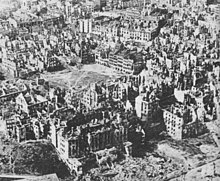
After the Warsaw Uprising, 85% of the city was deliberately destroyed by the German forces.
After the remaining population had been expelled, the Germans continued the destruction of the city.[7] Special groups of German engineers were dispatched to burn and demolish the remaining buildings. According to German plans, after the war Warsaw was to be turned into nothing more than a military transit station,[73] or even an artificial lake[149] – the latter of which the Nazi leadership had already intended to implement for the Soviet/Russian capital of Moscow in 1941.[150][151] The demolition squads used flamethrowers and explosives to methodically destroy house after house. They paid special attention to historical monuments, Polish national archives and places of interest.[152]
By January 1945 85% of the buildings were destroyed: 25% as a result of the Uprising, 35% as a result of systematic German actions after the uprising, and the rest as a result of the earlier Warsaw Ghetto Uprising, and the September 1939 campaign.[7] Material losses are estimated at 10,455 buildings, 923 historical buildings (94%), 25 churches, 14 libraries including the National Library, 81 primary schools, 64 high schools, University of Warsaw and Warsaw University of Technology, and most of the historical monuments.[7] Almost a million inhabitants lost all of their possessions.[7] The exact amount of losses of private and public property as well as pieces of art, monuments of science and culture is unknown but considered enormous. Studies done in the late 1940s estimated total damage at about US$30 billion.[153] In 2004, President of Warsaw Lech Kaczyński, later President of Poland, established a historical commission to estimate material losses that were inflicted upon the city by German authorities. The commission estimated the losses as at least US$31.5 billion at 2004 values.[154] Those estimates were later raised to US$45 billion 2004 US dollars and in 2005, to $54.6 billion.[155]
Casualties
The exact number of casualties on both sides is unknown. Estimates of casualties fall into roughly similar ranges. Polish civilian deaths are estimated at between 150,000 and 200,000.[8] Both Polish and German military personnel losses are estimated separately at under 20,000.[7][156]| Side | Civilians | KIA | WIA | MIA | POW |
|---|---|---|---|---|---|
| Polish | 150,000–200,000[8] | 15,200[7] 16,000[156] 16,200[157] |
5,000[7] 6,000[158] 25,000[8] |
all declared dead[156] | 15,000[7][156] |
| German[159] | unknown | 7,000 to 9,000 killed,[7] or 16,000 killed and missing[7] | 9,000[7][156] | 7,000[156][160] | 2,000[7] to 5,000[156] |
After the war
Main article: Cultural representations of the Warsaw Uprising

Mały Powstaniec
Monument erected just outside of Warsaw's medieval city walls in 1981,
commemorates the children who fought in the Warsaw Uprising, against the
German occupation.
"I want to protest against the mean and cowardly attitude adopted by the British press towards the recent rising in Warsaw. ... One was left with the general impression that the Poles deserved to have their bottoms smacked for doing what all the Allied wirelesses had been urging them to do for years past,. ... First of all, a message to English left-wing journalists and intellectuals generally: 'Do remember that dishonesty and cowardice always have to be paid for. Don't imagine that for years on end you can make yourself the boot-licking propagandist of the Soviet régime, or any other régime, and then suddenly return to mental decency. Once a whore, always a whore.'" –-George Orwell, 1 September 1944[161][162]Most soldiers of the Home Army (including those who took part in the Warsaw Uprising) were persecuted after the war; captured by the NKVD or UB political police. They were interrogated and imprisoned on various charges, such as that of "fascism".[163][164] Many of them were sent to Gulags, executed or "disappeared".[163] Between 1944 and 1956, all of the former members of Battalion Zośka were incarcerated in Soviet prisons.[165] In March 1945, a staged trial of 16 leaders of the Polish Underground State held by the Soviet Union took place in Moscow – (the Trial of the Sixteen).[166][167][168][169] The Government Delegate, together with most members of the Council of National Unity and the C-i-C of the Armia Krajowa, were invited by Soviet general Ivan Serov with agreement of Joseph Stalin to a conference on their eventual entry to the Soviet-backed Provisional Government.
They were presented with a warrant of safety, yet they were arrested in Pruszków by the NKVD on 27 and 28 March.[170][171] Leopold Okulicki, Jan Stanisław Jankowski and Kazimierz Pużak were arrested on the 27th with 12 more the next day. A. Zwierzynski had been arrested earlier. They were brought to Moscow for interrogation in the Lubyanka.[172][173][174] After several months of brutal interrogation and torture,[175] they were presented with the forged accusations of "collaboration with Nazi Germany" and "planning a military alliance with Nazi Germany".[176][177] Many resistance fighters, captured by the Germans and sent to POW camps in Germany, were later liberated by British, American and Polish forces and remained in the West. Among those were the leaders of the uprising Tadeusz Bór-Komorowski and Antoni Chruściel.[citation needed]

Graves of a Royal Hungarian Army Captain and 6 of his soldiers who died fighting for the Polish side.
By contrast, in the West the story of the Polish fight for Warsaw was told as a tale of valiant heroes fighting against a cruel and ruthless enemy. It was suggested that Stalin benefited from Soviet non-involvement, as opposition to eventual Soviet control of Poland was effectively eliminated when the Nazis destroyed the partisans.[180] The belief that the Uprising failed because of deliberate procrastination by the Soviet Union contributed to anti-Soviet sentiment in Poland. Memories of the Uprising helped to inspire the Polish labour movement Solidarity, which led a peaceful opposition movement against the Communist government during the 1980s.[181]
Until the 1990s, historical analysis of the events remained superficial because of official censorship and lack of academic interest.[182] Research into the Warsaw Uprising was boosted by the fall of communism in 1989, due to the abolition of censorship and increased access to state archives. As of 2004, however, access to some material in British, Polish and ex-Soviet archives was still restricted.[183] Further complicating the matter is the British claim that the records of the Polish government-in-exile were destroyed,[184] and material not transferred to British authorities after the war was burnt by the Poles in London in July 1945.[185][186]
In Poland, 1 August is now a celebrated anniversary. On 1 August 1994, Poland held a ceremony commemorating the 50th anniversary of the Uprising to which both the German and Russian presidents were invited.[9] Though the German President Roman Herzog attended, the Russian President Boris Yeltsin declined the invitation; other notable guests included the U.S. Vice President Al Gore.[9][187] Herzog, on behalf of Germany, was the first German statesman to apologize for German atrocities committed against the Polish nation during the Uprising.[187] During the 60th anniversary of the Uprising in 2004, official delegations included: German Chancellor Gerhard Schröder, UK deputy Prime Minister John Prescott and US Secretary of State Colin Powell; Pope John Paul II sent a letter to the mayor of Warsaw, Lech Kaczyński on this occasion.[188] Russia once again did not send a representative.[188] A day before, 31 July 2004, the Warsaw Uprising Museum opened in Warsaw.[188]
Photograph gallery
-
German SS-Gruppenführer Heinz Reinefarth nicknamed the "Butcher of Wola" (left, in Cossack headgear) alongside Jakub Bondarenko the commander of the 3rd Regiment of Kuban Cossack Infantry, pictured during the Warsaw Uprising, 1944
-
Azeri SS volunteer formation during the Warsaw Uprising.
-
Barricade erected such on Napoleon Square. In background: captured Hetzer tank destroyer. 3 August 1944
Popular culture
Numerous works have been influenced by the Uprising.In music, they include:
- Lao Che – Powstanie Warszawskie (Polish band Lao Che's concept album wholly dedicated to the Uprising)[189]
- Sabaton – "Uprising" (Swedish power/heavy metal band Sabaton's song about the event)
- Heaven Shall Burn – "Armia" (German metalcore/deathcore band)
- Slovenian industrial group Laibach released the EP "1 VIII 1944 Warszawa" to mark the seventieth anniversary of the uprising in 2014, in association with the Polish Ministry of Culture.
- The 2014 video game Enemy Front features levels about the uprising, playing the character of an American war correspondent who fights alongside the Polish Home Army.
Currently, the Polish director Małgorzata Brama intends to shoot a docudrama about Warsaw Uprising[190]
See also
- Kanał
- Kraków Uprising (1944)
- Cross of the Warsaw Uprising
- Ochota massacre
- Polish contribution to World War II
- Powstanie Warszawskie (album)
- Anglo-Polish Radio
- Robinson Crusoes of Warsaw
- Karl-Gerät – A super-heavy howitzer used against the uprising


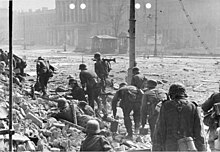

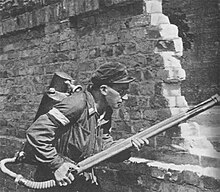
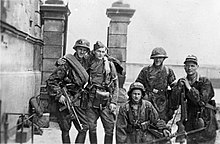

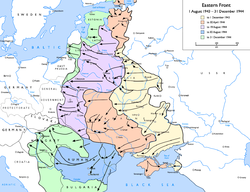



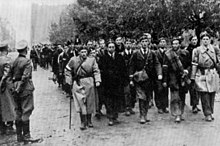




















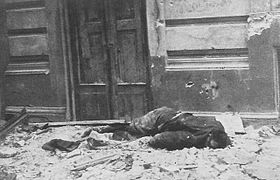



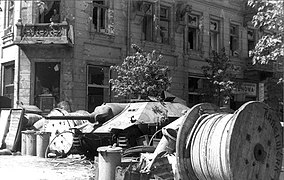

No comments:
Post a Comment
Please leave a comment-- or suggestions, particularly of topics and places you'd like to see covered